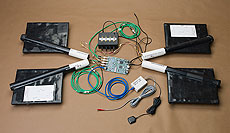Take a shower at Lederman Science Center

The detector in the cosmic ray exhibit is similar to this cosmic ray muon detector, assembled from a QuarkNet kit. Photo: Reidar Hahn
Folks can now head on over to the Lederman Science Center to take a shower-of cosmic rays, that is.
A new exhibit at Lederman Science Center dramatizes the presence of cosmic rays, which continuously pelt Earth. The rays, made up of protons and the nuclei of heavier atoms, collide with other molecules in Earth's atmosphere and split into decays of electrons, positrons and muons. These invisible decays, or showers, bathe the planet's lower atmosphere.
"Hopefully, people who participate will realize that we're immersed in cosmic rays all the time," said Todd Johnson, AD.
The display demonstrates the showers with low-energy lasers. A motion detector senses when a person steps into the phone booth-sized shower and lasers paint the individual in momentary lines of fluorescent color. A cartoon-laser sound of "pew-pew-pew" accompanies the traces.
Six scintillator panels housed in a clear panel overhanging the shower detect cosmic rays in real time. The lasers project at the approximate angle of the ray. On the wall, a counter keeps track of how many lasers hit the participant. Up to 350 showers may occur in a single minute.
Johnson designed the interface electronics and optics for the laser projector in collaboration with Sten Hansen, PPD, who designed the control electronics and modified the firmware that internally controls the electrons. Dave Hoppert, WDRS, built the customized cosmic ray detector.
"It took a while for our team to think through every feature of the display," Hoppert said. "And for the detector, we ended up using the basic components of a QuarkNet cosmic ray detector kit."
The QuarkNet program is a professional development program built around a research collaboration among students, teachers and physicists. Students build cosmic ray detectors and collect frequency and strength data.
"If people understand that this is something that happens all the time, maybe they'll gain an appreciation for the scale of things in the universe," Johnson said
Marge Bardeen, head of Fermilab's Education Office, praised the exhibit and those who put it together.
"It took a collaboration of people to turn this idea into a really cool exhibit," Bardeen said. "Everyone should come over to take a shower."
Editor's note: Dave Dumford, husband of docent Sue Dumford, did all of the carpentry for the display, and Liz Quigg, Education Office, designed and programmed the electronic display next to the exhibit with animations explaining cosmic rays.
—Ashley WennersHerron
|